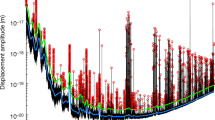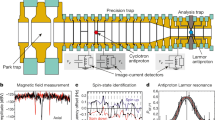Abstract
The standard model of cosmology provides a robust description of the evolution of the Universe. Nevertheless, the small magnitude of the vacuum energy is troubling from a theoretical point of view9. An appealing resolution to this problem is to introduce additional scalar fields. However, these have so far escaped experimental detection, suggesting some kind of screening mechanism may be at play. Although extensive exclusion regions in parameter space have been established for one screening candidate—chameleon fields10,17—another natural screening mechanism based on spontaneous symmetry breaking has also been proposed, in the form of symmetrons11. Such fields would change the energy of quantum states of ultracold neutrons in the gravitational potential of the Earth. Here, we demonstrate a spectroscopic approach based on the Rabi resonance method that probes these quantum states with a resolution of ΔE =2 × 10−15 eV. This allows us to exclude the symmetron as the origin of dark energy for a large volume of the three-dimensional parameter space.
This is a preview of subscription content, access via your institution
Access options
Access Nature and 54 other Nature Portfolio journals
Get Nature+, our best-value online-access subscription
$29.99 / 30 days
cancel any time
Subscribe to this journal
Receive 12 print issues and online access
$209.00 per year
only $17.42 per issue
Buy this article
- Purchase on Springer Link
- Instant access to full article PDF
Prices may be subject to local taxes which are calculated during checkout




Similar content being viewed by others
References
Rabi, I. I., Millman, S., Kusch, P. & Zacharias, J. R. The molecular beam resonance method for measuring nuclear magnetic moments. The magnetic moments of 3Li6, 3Li7 and 9F19. Phys. Rev. 55, 526–535 (1939).
Jenke, T., Lemmel, H., Geltenbort, P. & Abele, H. Realization of a gravity-resonance-spectroscopy technique. Nat. Phys. 7, 468–472 (2011).
Jenke, T. et al. Gravity resonance spectroscopy constrains dark energy and dark matter scenarios. Phys. Rev. Lett. 112, 151105 (2014).
Westphal, A. et al. A quantum mechanical description of the experiment on the observation of gravitationally bound states. Eur. Phys. J. C 51, 367–375 (2007).
Abele, H., Jenke, T., Leeb, H. & Schmiedmayer, J. Ramsey’s method of separated oscillating fields and its application to gravitationally induced quantum phase shifts. Phys. Rev. D 81, 065019 (2010).
Roulier, D. et al. Status of the GRANIT facility Adv. High. Energy Phys. 2015, 730437 (2015).
Cronenberg, G. Frequency Measurements Testing Newton’s Gravity Law with the Rabi-qBounce experiment. PhD thesis, Technische Universität Wien (2016).
Weber, M. Gravitation in der Interferometrie mit Kalten Neutronen. PhD thesis, University of Innsbruck (1998).
Joyce, A., Jain, B., Khoury, J. & Trodden, M. Beyond the cosmological standard model. Phys. Rep. 568, 1–98 (2015).
Khoury, J. & Weltman, A. Chameleon fields: awaiting surprises for tests of gravity in space. Phys. Rev. Lett. 93, 171104 (2004).
Hinterbichler, K. & Khoury, J. Screening long-range forces through local symmetry restoration. Phys. Rev. Lett. 104, 231301 (2010).
Hinterbichler, K., Khoury, J., Levy, A. & Matas, A. Symmetron cosmology. Phys. Rev. D 84, 103521 (2011).
Pietroni, M. Dark energy condensation. Phys. Rev. D 72, 043535 (2005).
Olive, K. A. & Pospelov, M. Environmental dependence of masses and coupling constants. Phys. Rev. D 77, 043524 (2008).
Brax, P. & Davis, A. C. Atomic interferometry test of dark energy. Phys. Rev. D 94, 104069 (2016).
Burrage, C., Kuribayashi-Coleman, A., Stevenson, J. & Thrussell, B. Constraining symmetron fields with atom interferometry. JCAP 1612, 041 (2016).
Jaffe, M. et al. Testing sub-gravitational forces on atoms from a miniature in-vacuum source mass. Nat. Phys. 13, 938–942 (2017).
Brax, P. & Burrage, C. Atomic precision tests and light scalar couplings. Phys. Rev. D 83, 035020 (2011).
Brax, P. & Pitschmann, M. Exact solutions to nonlinear symmetron theory: one- and two-mirror systems. Phys. Rev. D 97, 064015 (2018).
Brax, P., Burrage, C., Englert, C. & Spannowsky, M. LHC signatures of scalar dark energy. Phys. Rev. D 94, 084054 (2016).
Kapner, D. J. et al. Tests of the gravitational inverse-square law below the dark-energy length scale. Phys. Rev. Lett. 98, 021101 (2007).
Gea-Banacloche, J. A quantum-bouncing ball. Am. J. Phys. 67, 776–782 (1999).
Wallis, H., Dalibard, J. & Cohen-Tannoudji, C. Trapping atoms in a gravitational cavity. Appl. Phys. B 54, 407–419 (1992).
Jenke, T. et al. Gravity resonance spectroscopy constrains dark energy and dark matter scenarios. Phys. Rev. Lett. 112, 151105 (2014).
Nesvizhevsky, V. V. et al. Quantum states of neutrons in the Earth’s gravitational field. Nature 415, 297–299 (2002).
Baessler, S. et al. Frequency shifts in gravitational resonance spectroscopy. Phys. Rev. D 91, 042006 (2015).
Acknowledgements
H.A. thanks M. Faber and A. Ivanov for useful discussions. We gratefully acknowledge support from the Austrian Fonds zur Förderung der Wissenschaftlichen Forschung (FWF) under contract no. I529-N20, no. 531-N20 and no. I862-N20, and the German Research Foundation (DFG) as part of the Priority Programme (SPP) 1491 “Precision experiments in particle and astrophysics with cold and ultra-cold neutrons”. We also gratefully acknowledge support from the French L’Agence nationale de la recherche (ANR) under contract no. ANR-2011-ISO4-007-02, Programme Blanc International—SIMI4-Physique. This work is supported in part by the EU Horizon 2020 research and innovation programme under the Marie-Sklodowska grant no. 690575. This article is based upon work related to the COST Action CA15117 (CANTATA) supported by COST (European Cooperation in Science and Technology).
Author information
Authors and Affiliations
Contributions
G.C., H.F., P.G., M.T., T.J. and H.A. performed the experiment. G.C., T.J., M.P., H.F. and H.A. analysed the data. M.P., G.P. and P.B. provided the theoretical contributions. All authors contributed to the manuscript.
Corresponding author
Ethics declarations
Competing interests
The authors declare no competing interests.
Additional information
Publisher’s note: Springer Nature remains neutral with regard to jurisdictional claims in published maps and institutional affiliations.
Supplementary Information
Supplementary Information
Supplementary Notes 1–2, Supplementary Figure 1, Supplementary Table 1, Supplementary References 1–2
Rights and permissions
About this article
Cite this article
Cronenberg, G., Brax, P., Filter, H. et al. Acoustic Rabi oscillations between gravitational quantum states and impact on symmetron dark energy. Nature Phys 14, 1022–1026 (2018). https://doi.org/10.1038/s41567-018-0205-x
Received:
Accepted:
Published:
Issue Date:
DOI: https://doi.org/10.1038/s41567-018-0205-x
This article is cited by
-
Spin-orbit Rabi oscillations in optically synthesized magnetic fields
Light: Science & Applications (2023)
-
Experiments with levitated force sensor challenge theories of dark energy
Nature Physics (2022)
-
Tests of fundamental quantum mechanics and dark interactions with low-energy neutrons
Nature Reviews Physics (2021)
-
The dark side of neutrons
Nature Physics (2018)



